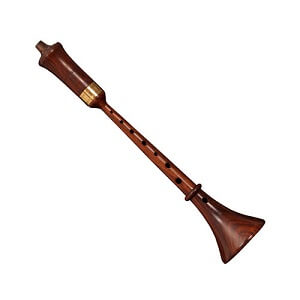Rauschpfeife
 The rauschpfeife is a loud reed-cap instrument with a double reed (like the krumhorn, hirtenschalmei, and cornamuse). Its bore is conical like the shawm, so it overblows the octave. Several notes of the upper register are useable. The name comes from the German rausch (noise) or rusch (reed). The Italian name for the instrument, schreierpfeife, is from schreien (to cry or scream). The rauschpfeife's screaming sound, full of overtones, gives it enough carrying power to be used outdoors, unlike the other reed-cap instruments. A famous woodcut. the The Triumph of Maximilian I, shows five rauschpfeifen and five shawms being played on horseback.
The rauschpfeife is a loud reed-cap instrument with a double reed (like the krumhorn, hirtenschalmei, and cornamuse). Its bore is conical like the shawm, so it overblows the octave. Several notes of the upper register are useable. The name comes from the German rausch (noise) or rusch (reed). The Italian name for the instrument, schreierpfeife, is from schreien (to cry or scream). The rauschpfeife's screaming sound, full of overtones, gives it enough carrying power to be used outdoors, unlike the other reed-cap instruments. A famous woodcut. the The Triumph of Maximilian I, shows five rauschpfeifen and five shawms being played on horseback.
Several sizes survive in collections in Berlin and Prague covering sizes from soprano to bass. The larger sizes have a little-finger key and a fontanelle for the lowest note as well as upward extension keys operated by the index finger for the upper range. Modern replicas include sopranino, soprano, alto, and tenor sizes. Like the rest of the early reed instruments, the rauschpfeife could only play chromatic tones outside the fundamental scale by using cross-fingerings and humouring on the players part.. This weakens the sound of some tones and produces rather unsteady results when played by less experienced performers.